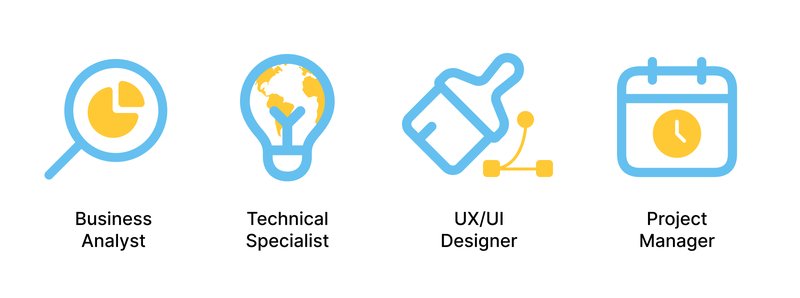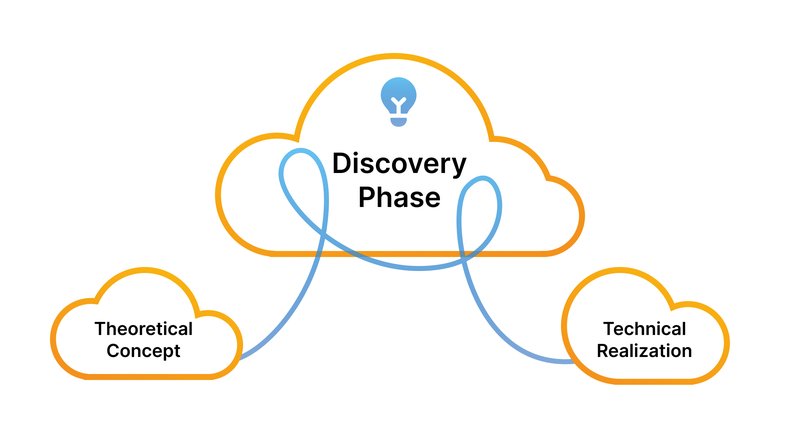Understanding the Discovery Phase in software development: Part 2

In Part 2, we will delve deeper into what both the client and the development team gain from the Discovery Phase. From solidifying timelines and budgets to providing a deeper understanding of the project’s scope and potential, this phase lays the groundwork for a successful and efficient development process.
Let’s explore how the Discovery Phase helps all parties involved make informed decisions and sets the project up for long-term growth.

What does the client gain from the Discovery Phase?
For the client, the Discovery Phase for software development is not just a preparatory step — it’s an investment that yields concrete and valuable outcomes, helping to minimize risks and make informed decisions moving forward. As a result of this phase, the client receives:
1. Justified timeline and budget estimate
Based on a step-by-step business analysis in the Discovery Phase, thorough requirement elaboration, and consideration of technical constraints, our team provides a realistic forecast for timelines, resource needs, and costs. This estimate is significantly more accurate than what can be derived from a verbal idea alone. The client gains an understanding of:
- How long will it take to implement both the MVP and the full version?
- What resources will be required?
- What potential risks exist, and what might affect the cost?
2. Structured product vision
The Discovery Phase transforms an abstract idea into a concrete concept. The output includes descriptions of:
- Product goals and value.
- User scenarios and process diagrams.
- Target audience and key user roles.
- Business processes and interaction flows.
- Functional and non-functional requirements.
- Constraints and external dependencies.
All this is documented in a business-friendly language, but with sufficient precision for the technical team to proceed with implementation.
3. Validation of technical feasibility
If needed, technical experts such as architects or tech leads are brought into the process. They evaluate:
- Potential implementation challenges.
- Suitable technologies and architecture options.
- Integration needs and their feasibility or complexity
- Possibilities for future scaling and ensuring system security.
4. UI/UX artifacts
Depending on the depth of the Discovery, the client receives:
- Flow maps or Customer Journey Maps.
- Wireframes or interface prototypes.
As a result, the benefits of the Discovery Phase for clients are numerous. This step gives the client confidence that the team understands the problem, that the budget aligns with expectations, and that the implementation approach is thoughtful and professional. It’s not only a way to better define the product but also a foundation for long-term growth.
What do we gain from the Discovery Phase?
The Discovery Phase is not just a way to help the client understand their product. For our company, it’s a strategically important stage that lays the foundation for future cooperation, builds trust, and reduces risks at every subsequent step of the project.
Below are the key outcomes our team receives from a well-executed Discovery Phase:
1. Deep understanding of the project and its context
During Discovery, the team immerses itself in:
- Business goals and objectives.
- The needs of the target audience.
- Domain-specific challenges.
- Stakeholder expectations.
- Constraints and potential risks.
This level of immersion significantly reduces uncertainty and lowers the chances of having to revisit earlier decisions during development.
2. Validation of alignment between expectations and capabilities
Discovery serves as a "compatibility check." We compare:
- The client’s expectations around timeline, budget, and scope.
- With our competencies, resources, and technology stack.
This helps us determine early on whether the project is a good fit and avoid taking on engagements that fall outside our reliable delivery zone.
3. Opportunity to demonstrate our approach and processes
The Discovery Phase is a chance to showcase our way of working:
- How do we gather, structure, and formalize information?
- How do we think in terms of product logic?
- How do we build communication channels?
- How flexibly and professionally do we adapt to project specifics?
This strengthens client trust and increases the likelihood of securing a long-term contract or being retained for subsequent phases.
4. Risk mitigation
Thanks to Discovery, we can:
- Identify weak spots in business logic early on.
- Clarify user roles and scenarios.
- Establish realistic technical solutions.
- Align timeline and budget expectations.
- Pinpoint critical integration areas or third-party dependencies.
This minimizes the number of unpleasant surprises during development and helps avoid costly rework.
5. Predictable and efficient start of development
By the end of Discovery, the team already has:
- User scenarios.
- A complete set of requirements.
- Process diagrams and flowcharts.
- Basic prototypes or wireframes.
This enables quick team assembly, reduces onboarding time, and allows development to start with minimal delays.
6. Initial backlog and release planning
Discovery allows us to predefine:
- The structure of the product backlog.
- Task priorities.
- A release roadmap.
This is particularly valuable for project managers, analysts, and tech leads, as it simplifies resource planning and forecasting for MVP launch and production rollout.
In summary, Discovery provides us not only with Discovery Phase deliverables but also with alignment, shared understanding, and mutual trust with the client. It’s a crucial investment in reducing risks and ensuring successful long-term project execution.

Next steps after the Discovery Phase
Depending on the outcomes of the Discovery Phase, a project may evolve in different directions. Here are the most common scenarios:
1. Transition to the development phase
If, after analysis and alignment, both parties are confident in the chosen direction, the project moves into implementation. This is the ideal outcome:
- The project team is assembled.
- Timeline, budget, and release structure are clarified.
- Technical development is initiated.
During the development phase, the Discovery team supports the transition by helping others onboard, sharing knowledge, and refining requirements when needed.
2. Strategy revision and adaptation
Sometimes, Discovery reveals that:
- The original idea is too large or too risky.
- Client expectations don’t align with the budget or timeline.
- A shift in focus or prioritization is required.
In these cases, adjustments may include:
- Isolating an MVP to reduce initial costs.
- Removing low-priority or non-essential features.
- Revisiting technology or architectural choices.
- Repositioning the product for a different audience or business objective.
This approach enables a project to pivot rather than be canceled, making it more realistic and achievable.
3. Leveraging Discovery artifacts for external use
The outputs of the Discovery Phase have value beyond the current team. They can be used for:
- Presentations to stakeholders or executives.
- Attracting investors or preparing for fundraising rounds.
Our goal is to make these artifacts clear, visual, and intuitive — even for people who weren’t directly involved in the Discovery process.
4. Ongoing support from our team
Even if development is handled by another team or delayed, we can continue to support the project:
- As consultants or system architects.
- As business analysts or project managers.
- During product scaling, enhancement, or deployment.
This ensures continuity, preserves the logic of earlier decisions, and saves time on onboarding new contributors.
It’s important to remember: Discovery is not just about gathering requirements. It’s about eliminating illusions, finding a realistic path forward, and laying a solid foundation for the product.
If you want to build a product with a clear focus and strong execution, start with a proper Discovery Phase.
Conclusion
The Discovery Phase is a critical investment for both the client and the development team. For the client, it provides clarity on timelines, budgets, and product vision, while helping to identify potential risks and refine the approach. For the development team, it’s an opportunity to ensure alignment, validate technical feasibility in the Discovery Phase, and mitigate risks, setting the project up for long-term success.
To ensure your project’s foundation is solid, it’s essential to begin with a well-executed Discovery Phase. Ready to move forward with your project? Contact us to negotiate the software Discovery Phase consulting cost and set your project up for a smooth transition into development.